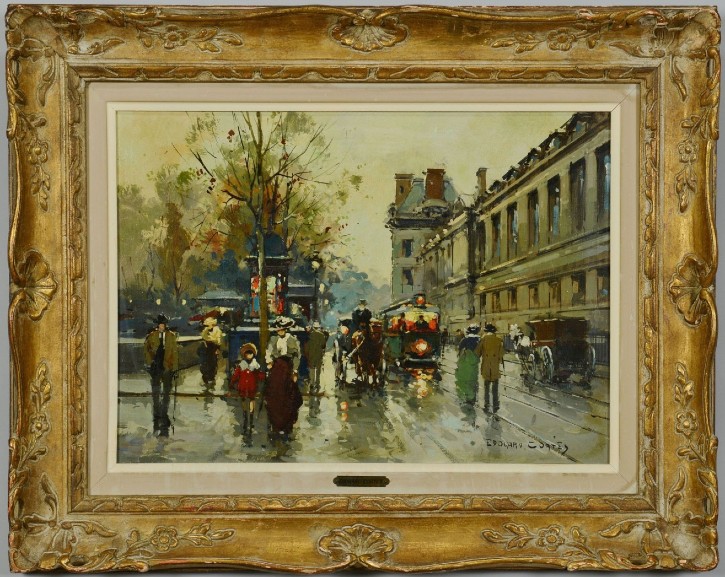
NEW YORK – Few artists have been able to capture the romance, energy and charm of old Paris as nimbly as Edouard Léon Cortès (1882-1968), the French post-impressionist painter who dedicated most of his life to seizing the magic of Paris during its transition from the romantic “belle epoque” to the modern, 20th century capital city it is today. Cortès split his time between Paris and Lagny-sur-Marne, France, where he was born and where he died. He’s most known for his Paris cityscapes.
If Cortès’ name doesn’t sound French, it’s because his father, Antonio Cortès, was a painter for the Spanish Royal Court. His mother was French. Edouard learned the basic disciplines of landscape painting from his father and at age 17 he enrolled in the Ecole des Beaux-Arts in Paris. There, he studied the various forms of classical and impressionistic painting. In 1901, while still in his teens, Cortès exhibited his work at the prestigious Salon des Artistes Francais in Paris.
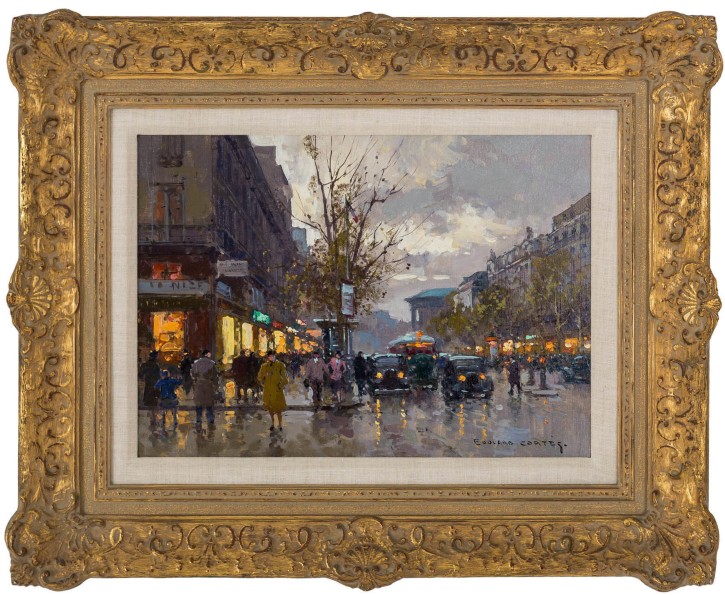
Cortès paintings captured the essence of old Paris through bold brush strokes and intriguing colors. The viewer’s eye was often caught by fascinating details: the play of lights on wet pavement, shadows on streets and glowing windows and lamps. On his canvases one could find an array of tones ranging from soft gray hues and ambers to vivid reds, yellows and oranges. A splash of purple may be a man’s tailored dinner jacket or a stroke of blue a woman’s cloak.
Cortès was enthralled by the north French countryside and produced many landscapes during his prolific career, most of them early on. Later, he became renowned as “Le Poete Parisien de la Painture” (or, “The Parisian Poet of Painting”) because of his diverse Paris cityscapes in a wide variety of weather and night settings. His style changed little along the way; in the 1950s he was still showing horse-drawn carriages and styles of clothing that had long vanished from the real streets of Paris. When asked why, he said he wanted to halt history at 1939, before the trauma of World War II changed Paris forever.
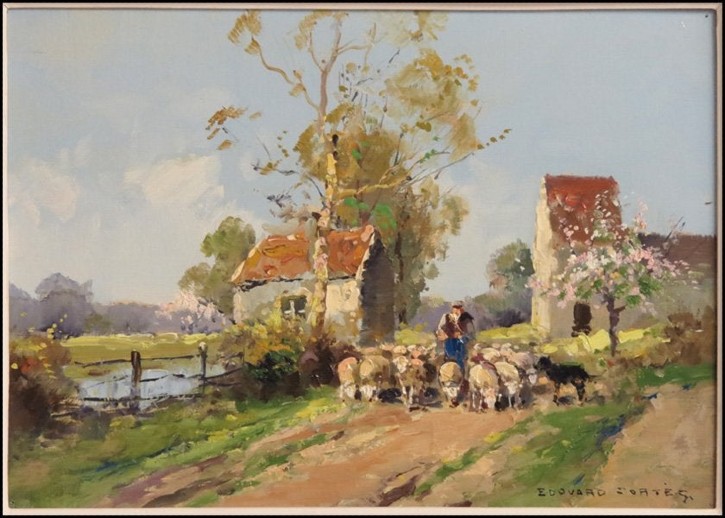
Sarah Campbell Drury, vice president of Fine and Decorative Arts at Case Antiques Inc. in Knoxville and Nashville, Tennessee, said Cortès had a special gift for capturing the romantic essence of Paris – “not just the architecture and the crowds, but the mood of it. If you’ve ever been to Paris you know how different the city can feel depending on the time of day and the weather.”
Drury said Cortès used his skillful brushstrokes and thoughtful palette to convey the effect of rain, sunshine, snow, sunset, on the city, “and that really speaks to people.” She added, “His other scenes also exhibit this same mastery of light and palette, but because so many people feel an emotional attachment to Paris, and so many of the landmarks he painted still look so much the same, it’s his Paris scenes for which he is best loved.”
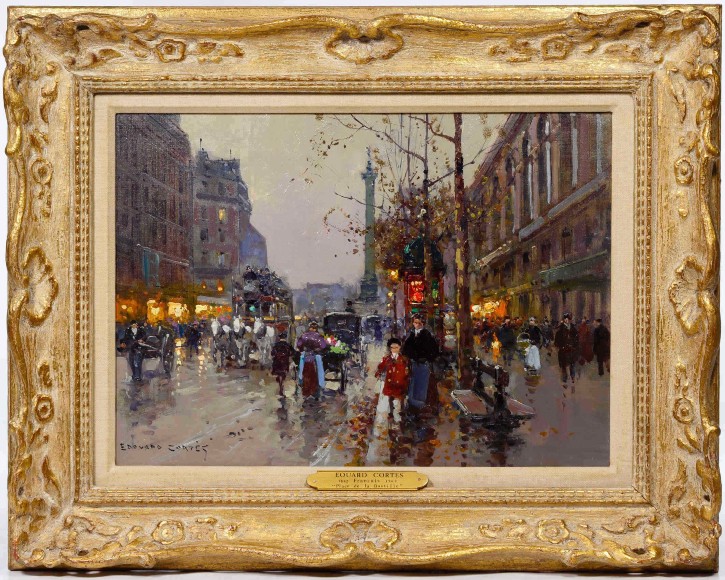
John Leonard, president and auctioneer of Leonard Auction Inc. in Addison, Illinois, believes the demand for Cortès’s work is two-fold. “First, Impressionism has always been a popular style and one that collectors have gravitated towards for many decades,” he said. “Secondly, and I think the biggest reason for Cortès’s popularity, is his subject matter. For many Americans, Paris has always been an idyllic place and one that is very popular for vacations.”
Leonard said Cortès’s street scenes, especially, capture unmistakable Paris landmarks and take the viewer of the painting back to that place. “I think of a buyer we had that fell in love with one of the scenes as it reminded them of their honeymoon in Paris and had to own the painting. Cortès was also a very talented and consistent painter, which I believe has also helped his works to stand his contemporaries.”
Joe Baratta at Abell Auction in Los Angeles said Cortès’s name has always been equated with quality, as he was one of the finer painters of these popular Parisian scenes. “However,” he pointed out, “with being at the top of the field comes issues like the number of fake works on the market attributed to Cortès. We have had a few come into our showroom in the past; there are good fakes and really poor examples. One assumes that because a canvas has the pinprick that Cortès used, their work must be authentic.”

Baratta said the market for Cortès and other painters like him is softer than it has been in the past, as tastes trend away from traditional to more contemporary. “However,” he added, “when one is buying the best of a certain category, a work will maintain its value. This is why Cortès’s works sell for more than, say, Antoine Blanchard, and a Tiffany Studios lamp will sell for more than some of its contemporaries.”
John Leonard said the demand for Cortès’s work peaked, at least at auction, in the early 2000s. “We sold a collection of 10 Cortès works in 2019 for a Chicago area estate. The paintings had been collected over a period of about 25 years and the purchase prices ranged from $1,500 on the low end to $37,000 on the high end. When we offered the collection at auction, the sales prices ranged from $15,340-$25,960.”
Leonard said there’s still solid interest in Cortès’ works, but buyers are more skeptical of his pieces due to the abundance of fakes and “after” works in the marketplace. “We have found it critical to work with Vicki Arnot of Arnot Galleries in New York and Nicole Verdier in Paris to authenticate and trace the provenance for any Cortès work prior to sale,” he said.
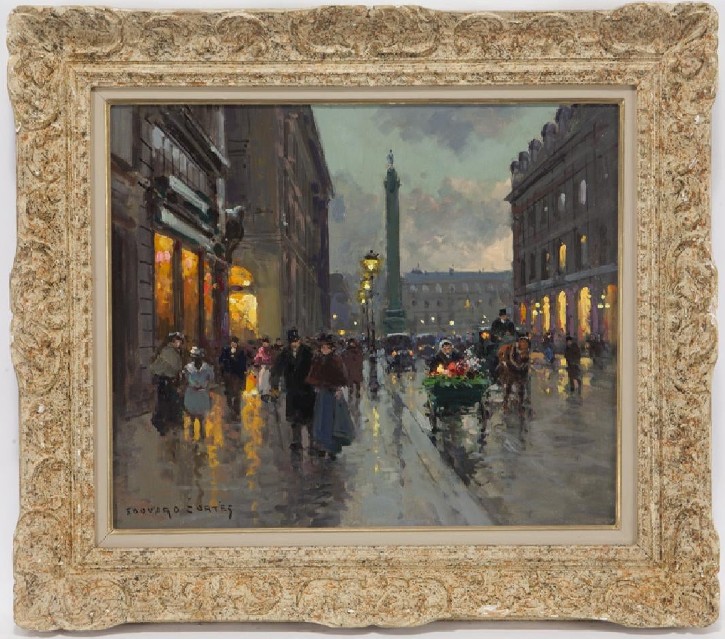
Leonard acknowledged that Cortès’ works have remained sought after for the last 40 years and he sees no reason to believe there won’t be a continued demand. “Many different tastes, trends and styles have come and gone in that time, but his paintings have continued to be valued by collectors,” he said. “The pricing for the pieces may change over time but I think a solid demand will always be there.”
Sarah Campbell Drury said, like many artists, prices for Cortès’s works peaked just before the 2008 recession (at about $114,000, including the buyer’s premium, according to Askart “The Artist’s Bluebook”). “They rebounded slightly around 2015, but have dropped some in the last five years as the market for abstract art has gotten hotter,” she said.
Drury said it’s possible to purchase a very fine Cortès painting for $50,000-$60,000 these days, and there are also good values in lower price ranges. “Buyers for paintings by Cortès may not face as much competition as they did before the Great Recession,” she said, “but there’s always a place in the market for the ‘best of the best’ – and Cortès really is one of the best when it comes to atmospheric depictions of Paris.”



